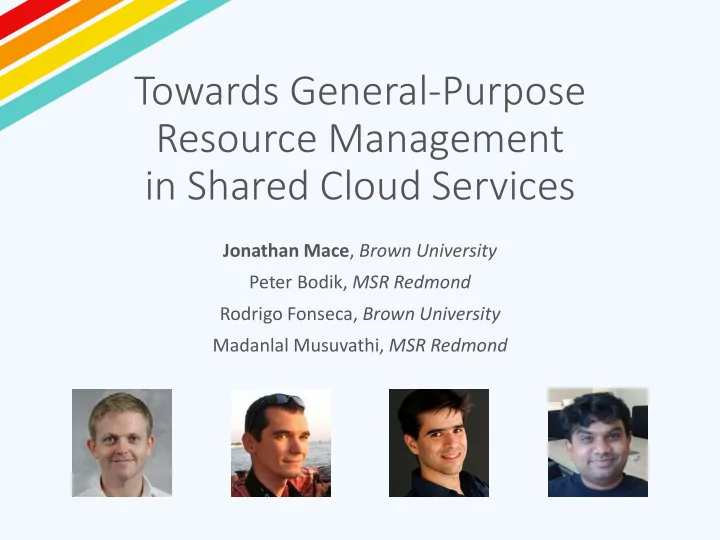

Towards General-Purpose Resource Management in Shared Cloud Services Jonathan Mace , Brown University Peter Bodik, MSR Redmond Rodrigo Fonseca, Brown University Madanlal Musuvathi, MSR Redmond
Shared-tenant cloud services Processes service requests from multiple clients ✓ Great for cost and efficiency ✘ Performance is a challenge Aggressive tenants and system maintenance tasks Resource starvation and bottlenecks Degraded performance, Violated SLOs, system outages 2
Shared-tenant cloud services Ideally manage resources to provide end-to-end guarantees and isolation Challenge OS/hypervisor mechanisms insufficient ✘ Shared threads & processes ✘ Application-level resource bottlenecks (locks, queues) ✘ Resources across multiple processes and machines Today lack of guarantees, isolation some ad-hoc solutions 3
This paper • 5 design principles for resource policies in shared- tenant systems • Retro – prototype for principled resource management • Preliminary demonstration of Retro in HDFS 4
Hadoop Distributed File System (HDFS) HDFS DataNode HDFS NameNode HDFS DataNode HDFS DataNode Replicated block storage Filesystem metadata 5
Hadoop Distributed File System (HDFS) HDFS DataNode HDFS NameNode HDFS DataNode HDFS DataNode Replicated block storage Filesystem metadata 6
7
8
HDFS DataNode HDFS NameNode HDFS DataNode HDFS DataNode 9
HDFS DataNode HDFS NameNode HDFS DataNode HDFS DataNode 10
HDFS DataNode HDFS NameNode HDFS DataNode HDFS DataNode 11
Principle 1: Consider all resources and request types • Fine-grained resources within processes • Resources shared between processes (disk, network) • Many different API calls • Bottlenecks can crop up in many places hardware resources: disk, network, cpu , … software resources : locks, queues, … data structures: transaction logs, shared batches, … 12
HDFS DataNode HDFS NameNode HDFS DataNode HDFS DataNode 13
HDFS DataNode HDFS NameNode HDFS DataNode HDFS DataNode 14
HDFS DataNode HDFS NameNode HDFS DataNode HDFS DataNode 15
HDFS DataNode HDFS NameNode HDFS DataNode HDFS DataNode 16
Principle 2: Distinguish between tenants • Tenants might send different types of requests • Tenants might be utilizing different machines • If a policy is efficient , it should be able to target the cause of contention e.g., if a tenant is causing contention, throttle otherwise leave the tenant alone 17
HDFS DataNode HDFS NameNode HDFS DataNode HDFS DataNode 18
Admission Control HDFS DataNode HDFS NameNode HDFS DataNode HDFS DataNode 19
Admission Control HDFS DataNode HDFS NameNode HDFS DataNode HDFS DataNode while (!Thread. isInterrupted ()){ sendPacket(); } 20
Admission Control HDFS DataNode HDFS NameNode HDFS DataNode HDFS DataNode Principle 5: while (!Thread. isInterrupted ()){ rate_limit(); Schedule early, sendPacket(); } schedule often 21
Resource Management Design Principles 1. Consider all request types and all resources 2. Distinguish between tenants 3. Treat foreground and background tasks uniformly 4. Estimate resource usage at runtime 5. Schedule early, schedule often Retro – prototype for principled resource management in shared-tenant systems 22
Retro: end-to-end tracing Tenants 23
Retro: end-to-end tracing Tenants 24
Retro: application-level resource interception Tenants 25
Retro: aggregation and centralized reporting Tenants 26
Retro: application-level enforcement Tenants 27
Retro: distributed scheduling Tenants 28
Retro: distributed scheduling Tenants 29
Early Results 1.1 1.2 HDFS Normalized Throughput HDFS w/ Retro HDFS NNBench Normalized Latency benchmark 0.01% to 2% 1 average overhead 1 on end-to-end latency, throughput 0.9 0.8 Open Read Create Rename Delete Open Read Create Rename Delete 30
HDFS DataNode HDFS NameNode HDFS DataNode HDFS DataNode 31
HDFS DataNode HDFS NameNode HDFS DataNode HDFS DataNode 32
Retrospective Thus far: • Per-tenant identification • Resource measurements • Schedule enforcement Next steps: • Abstractions for writing simplified high-level policies • Low-level enforcement mechanisms • Policies to monitor system, find bottlenecks, provide guarantees 33
Recommend
More recommend